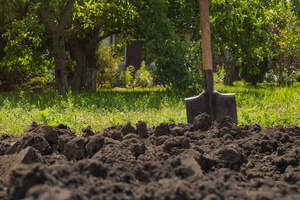The Ultimate Guide to Rototilling: Everything You Need to Know
Are you considering rototilling your garden but feeling overwhelmed by all the information out there? Look no further! In this comprehensive guide to rototilling, we’ve got you covered with everything you need to know to make the most of this gardening technique. Whether you’re a beginner or an experienced gardener, we will walk you through the benefits of rototilling, when and how to do it, and essential tips to achieve the best results.
Rototilling can be a powerful tool to improve your soil’s fertility, reduce weed growth, and enhance water absorption. You’ll learn about the different types of rototillers and which one is best suited for your needs, as well as how to prepare your garden prior to tilling. We’ll also touch on common mistakes to avoid and provide troubleshooting tips to ensure a smooth rototilling experience.
So, grab your gardening gloves and get ready to dive into the ultimate guide to rototilling. Transform your garden into a thriving oasis with this tried-and-true technique.
The Benefits of Rototilling
Rototilling offers numerous benefits that can help you achieve a healthy and productive garden. One of the primary advantages of rototilling is improving soil fertility. When you till the soil, you break it up into smaller particles, allowing for better air circulation and nutrient distribution. This helps plants access the necessary elements for growth, leading to healthier and more robust crops.
Another benefit of rototilling is the reduction of weed growth. By thoroughly tilling the soil, you disrupt the growth cycle of weeds, making it easier to remove them. Additionally, rototilling can help bury weed seeds deeper into the soil, preventing their germination and reducing the overall weed population in your garden.
Furthermore, rototilling aids in enhancing water absorption. When you till the soil, you loosen its structure, allowing water to penetrate more deeply. This prevents runoff and encourages the roots of your plants to grow deeper, making them more resilient during dry periods.
When to Use a Rototiller
Knowing when to use a rototiller is crucial to maximize its benefits and avoid potential pitfalls. The best time to rototill your garden is in the spring, a few weeks before planting. This allows the soil to settle and organic matter to decompose, creating a fertile environment for your plants. Avoid tilling when the soil is too wet, as this can lead to compaction and damage the soil structure.
If you have an established garden, you may also consider rototilling in the fall after you’ve harvested your crops. This gives you the opportunity to amend the soil with organic matter and prepare it for the next growing season. However, be cautious not to over-till, as excessive tilling can disrupt the beneficial organisms in the soil.
Choosing the Right Rototiller for Your Needs
Selecting the right rototiller is essential to ensure efficient and effective tilling. There are two main types of rototillers: front-tine and rear-tine. Front-tine tillers are generally smaller and more maneuverable, making them suitable for smaller gardens or tight spaces. Rear-tine tillers, on the other hand, are larger and more powerful, making them ideal for larger gardens or areas with compacted soil.
Consider the size of your garden, the type of soil you have, and your physical capabilities when choosing a rototiller. Electric or gas-powered models are available, with gas-powered tillers offering more power but also more noise and maintenance requirements. Take your time to research and compare different models to find the one that best suits your needs.
Preparing Your Garden for Rototilling
Properly preparing your garden before rototilling can significantly impact the success of your tilling efforts. Start by clearing the area of any debris, rocks, or large roots that may obstruct the rototiller’s path. This will prevent damage to the machine and ensure a smoother tilling process.
Next, mark any underground utilities, such as water lines or electrical cables, to avoid accidentally damaging them. It’s crucial to have a clear understanding of what lies beneath the surface before operating the rototiller.
Once you’ve cleared the area and marked any utilities, it’s time to remove any existing vegetation. Trim or mow the grass and weeds as short as possible to make tilling easier and more efficient. You can either compost the vegetation or dispose of it in an appropriate manner.
How to Properly Rototill Your Garden
Now that you’ve prepared your garden, it’s time to dive into the actual rototilling process. Start by adjusting the depth of the rototiller based on the type of soil and the desired results. For heavy or compacted soil, a deeper tilling depth may be necessary, while lighter soils may require less depth.
Begin tilling by moving the rototiller in straight lines, overlapping each pass by about one-third. This ensures that the entire area is adequately tilled. Keep a steady pace, allowing the machine to do the work. Avoid rushing or pushing too hard, as this can strain both you and the rototiller.
As you till, pay attention to any areas that may require extra attention. For example, if you encounter compacted soil or areas with poor drainage, spend additional time tilling and loosening the soil to improve its structure. Rototilling should be a thorough and methodical process, ensuring all areas receive equal treatment.
Tips for Maintaining Your Rototiller
Proper maintenance of your rototiller is vital to ensure its longevity and optimal performance. After each use, clean the machine thoroughly, removing any debris or soil that may have accumulated. Check the blades and tines for any signs of damage and replace them if necessary. Lubricate all moving parts according to the manufacturer’s instructions.
Regularly inspect the air filter and spark plug, cleaning or replacing them as needed. Check the oil level and top it up if required. It’s also a good idea to sharpen the blades or tines at the beginning of each gardening season to ensure efficient tilling.
Lastly, store your rototiller in a dry and secure location, protecting it from the elements. Proper storage will prevent rust and other damage, extending the lifespan of your machine.
Common Mistakes to Avoid When Rototilling
While rototilling can be an excellent gardening technique, there are several common mistakes that you should avoid to achieve the best results. One of the most common mistakes is over-tilling. Excessive tilling can disrupt the soil structure and damage the beneficial microorganisms living in the soil. Remember, tilling is meant to improve the soil, not pulverize it.
Another mistake to avoid is tilling when the soil is too wet or too dry. Wet soil can become compacted, leading to poor drainage and a hard, clumpy texture. On the other hand, tilling dry soil can create a dusty and powdery surface, making it challenging for seeds to germinate.
Additionally, avoid tilling the same area too often. Over-tilling can lead to soil compaction and nutrient depletion, defeating the purpose of tilling in the first place. Stick to tilling only when necessary, such as during soil preparation or when addressing specific issues.
Alternative Methods to Rototilling
While rototilling is a popular gardening technique, it’s not the only option available. There are alternative methods that can achieve similar results without the use of a rototiller. One such method is double-digging, which involves manually loosening the soil by digging two spade-depths down. This helps improve soil structure and allows for better root penetration.
Another alternative is the use of a broadfork, a tool designed to aerate and loosen the soil without inverting it. By inserting the broadfork into the soil and gently rocking it back and forth, you can break up compacted layers and improve drainage.
Additionally, cover cropping and mulching can help improve soil fertility and reduce weed growth without disturbing the soil structure. These methods involve planting cover crops or applying organic mulch to the soil surface, providing a protective layer and adding organic matter as they decompose.
Conclusion: Is Rototilling Right for You
Rototilling can be a valuable gardening technique when used appropriately and with the right considerations. It offers benefits such as improved soil fertility, reduced weed growth, and enhanced water absorption. By understanding when and how to use a rototiller, choosing the right machine, and properly preparing your garden, you can achieve excellent results.
Remember to avoid common mistakes such as over-tilling, tilling at the wrong soil moisture levels, and tilling too often. Additionally, consider alternative methods to rototilling if they align better with your gardening goals and preferences.
Now that you’ve gained a comprehensive understanding of rototilling, it’s time to put your knowledge into practice and transform your garden into a thriving oasis. Happy tilling!
Maximizing Garden Success with Professional Rototilling Services
For those managing large gardens, professional rototilling services using specialized equipment, like a track loader with a rototiller attachment, can save time and ensure optimal soil preparation. This service is ideal for improving soil structure, enhancing water absorption, and reducing weed growth efficiently. By choosing professional rototilling, you can achieve the best results for your garden, allowing your plants to thrive in well-prepared soil.
Enhance Large Gardens with Our Professional Rototilling Services
Explore our rototilling service perfect for larger gardens, featuring our track loader with a rototiller attachment. Check out this video for more information: Watch Here. Contact us today to schedule your service and transform your garden efficiently!
Summary

Dirt Connections was started with one goal in mind: providing quality residential and commercial construction services to clients on time and on budget. Reach out for more information on how we can support your next project.
For your convenience our estimates are free and by appointment. Call 703-940-9949 for a free estimate today!













































